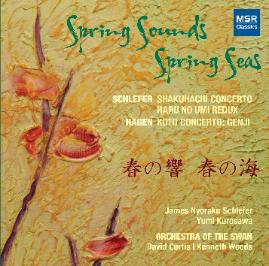FANFARE MAGAZINE
NOVEMBER / DECEMBER 2012
SCHLEFER Haru no Umi Redux and Shakuhachi Concerto
HAGEN Koto Concerto: Genji
ORCHESTRA OF THE SWAN

David Curtis and Kenneth Woods, conductors
James Nyoraku Schlefer, shakuhachi
Yumi Kurosawa, 20-string koto
MSR 1429 (64:24)
Despite his Brooklyn origins, James Nyoraku Schlefer is a Grand Master of the shakuhachi (one of only a small number of non-Japanese to hold that title). He studied in Japan and New York. Schlefer’s Haru no Umi Redux (2011) is his own take on a Japanese shakuhachi and koto duo of that name composed in 1929 by koto master Michiyo Miyago. The opening phrases, in Japan, now denote the New Year’s holiday. Schlefer adds his own material before the opening (and at its reprise). It is a delightful piece, and it certainly sounds as though the Swan Orchestra enjoyed playing it. The recording is topflight.
Once one has heard the plangent, evocative sound of a shakuhachi, it is not easily forgotten. Schlefer’s Shakuhachi Concerto begins in decidedly Debussian fashion (it is marked “Hazy awareness,” which certainly implies an Impressionist basis). Scored for solo shakuhachi, strings, harp, and percussion, it boasts a long, slow first movement. The mix of West and East is impressively managed in terms of musical language: Schlefer will begin a melody in decidedly occidental manner before adding an orientalist twist as the theme progresses. The second movement, “Crystal Solitude,” does not quite convey the yearning, lonely quality this instrument is normally associated with, despite beginning with a solo cadenza for the solo instrument, but it is atmospheric nonetheless, and the idea of a loss of solid pulse continues throughout most of the rest of the movement. The finale, a rondo, moves the goalposts substantially, juxtaposing varied, rhythmic sections against the delicacy of the preceding two movements. The Swan Orchestra comes into its own here; Schlefer is a fine player throughout, and his own best advocate. This is memorable music in fine performances.
Daron Hagen’s operas have served him in good stead when it comes to his Koto Concerto, “Genji” (2011). The “Genji” title refers to the 11th-century Tale of Genji. The music is certainly descriptive of the five scenes it seeks to depict from Genji’s life (Genji was son of the Emperor, relegated to commoner status). His adventures are described in the story; Hagen takes five scenes and explores them as psychological situations. The first movement, “Cicada Shell,” seems to speak more of film music than opera, though. The solo violin (accompanied by koto) that opens the second movement, “Falling Flowers,” seems strangely to refer to Rimsky’s Scheherazade. The “Maiden on the Bridge” speaks of oriental delicacy and is superbly played by the soloist, Yumi Kurosawa, while “Floating Bridge of Dreams” is a more virtuoso affair (for both soloist and orchestra).
-Colin Clarke
This article originally appeared in Issue 36:2 (Nov/Dec 2012) of Fanfare
Magazine.
CLICK HERE TO PURCHASE
Recent Comments